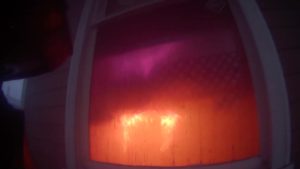“Hit and Move” (hit it, shut it, move it) on the left, “Push” (flowing while moving) on the right.
We’ve gone through a process of trying to articulate what conditions necessitate a push in our recruit academy, which has expanded to our county now. We are trying to dial in as specifically as possible a trigger point that a brand new pipeman would be able to know “I need to keep the nozzle open”. Although the fire ground is not a sterile environment, and decisions are not always clear cut, we are trying to show and place recruits in an environment as close to real as possible so that they can build RPD that will translate to the fires they see on the street.
Both of these fires in the above videos are single room fires driven to flashover. Our current trigger points for when it would be ok to do a hit and move are 1: Unshielded seat that is still compartmentalized (contents fire that you do not have to flow while approaching). 2: You want to earn a space to move in to so that you can Push (cool the space ahead of you, shut down and move into it so that you can push the next compartment). 3: Early to mid-stage growth fires and below.
The baseline mentality going in a building is to push. When in doubt, flow water. But if you find a smaller fire with conditions like the above, hitting and moving can be appropriate.
The hit and move is less laborious (slightly), and can be very fast, but as the above video shows and as UL data has articulated, the moment the nozzle is shut down the heat is given the ability to return quickly. This left video was a good example of why a shielded seat fire should have been pushed. In order to get an angle on the room, the nozzle had to get too close to open which exposed them to more heat. Also, the nozzle was not able to map water throughout the room until they were inside the doorway. A fire that has driven to flashover and is extending beyond the compartment of origin has plenty of energy behind it to rebound temperatures once the nozzle is shut unless the water is able to map into the room throughout, which it was not. Conversely, the push on the right stuffs the heat back into the room, seals it off and allows a safe approach to the doorway of the fire room so that the nozzle can get into the room without heat return.



